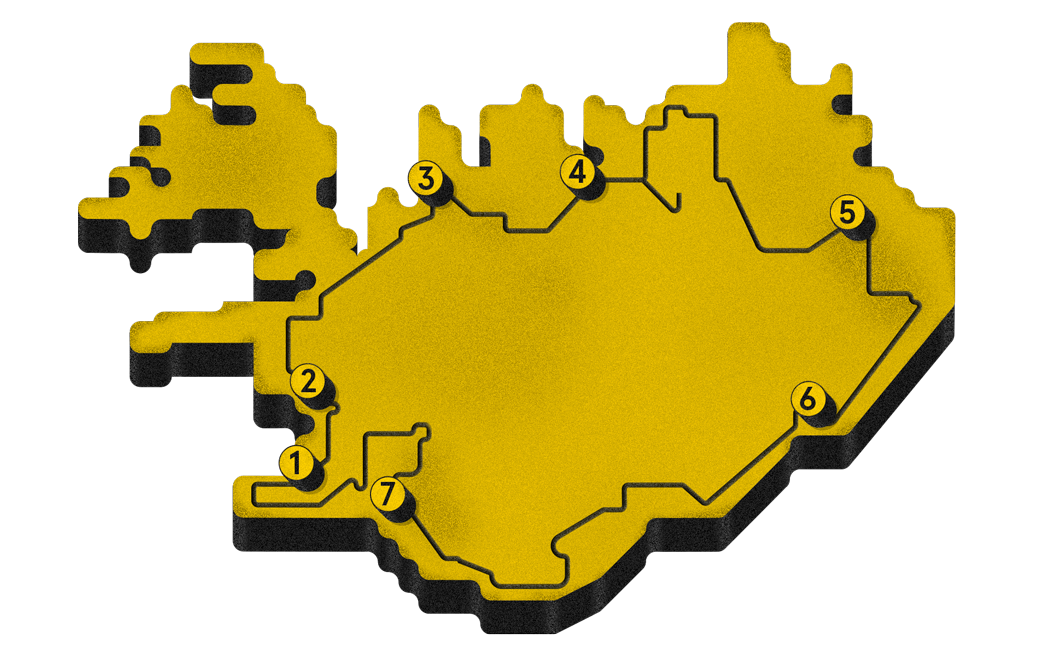-

The Road
Less TravelledRoute 1/Hringvegur
Date: 1974
Client: The Icelandic Road and
Coastal Administration (IRCA)d -
It says something about the contemporary visitor-pulling power of Iceland that a piece of infrastructure meant to take you to destinations has become a destination itself. However, considering the awe-inspiring landscape that Iceland’s national ring road (the Hringvegur or Route 1) tours through, it’s not hard to see why. Travelling the 1,340 kilometres of Route 1 has to be one of the world’s ultimate road trips.
But scenic beauty can be deceptive. Anyone expecting a smooth ride will encounter some bumpy interruptions, as some sections are still lined with the finest Icelandic gravel as opposed to asphalt. Additional hazards can include deadly winds, blizzards, ice, earthquakes, floods and – if you are really unlucky – volcanic eruptions. At least one point along the length of the road is usually closed for some reason or other, especially in winter. The 880m bridge crossing the Skeiðará river, for example, was the last piece of this orbital puzzle when it was completed in 1974, but in 1996 it was partially destroyed by a glacier run (a chunk of the original bridge still lies embedded in the ground beside its successor, a sober reminder to anyone who might dare think human engineering can outdo the power of nature here).
Previous page: photo by Fiona Shipwright. This page: Flickr/Chris Goldberg. (CC BY-NC 2.0)
-
A glance at the map of the Hringvegur is also a good way of reminding (or teaching) visitors that Reykjavík (1) is not the only place in Iceland. Stops along the way include Borgarnes (2), a historical centre and one of country’s first settlements; Blönduós (3), home to one of the country’s many distinctive churches, designed by Dr. Maggi Jónsson; Akureyri (4), Iceland’s second city, located just under the Arctic Circle; Egilsstaðir (5) a young township, est. 1947, whose 1970s church designed by Hilmar Ólafsson has fine acoustics; Höfn (6), host of an annual Humarhátíð (lobster) festival; and Selfoss (7) home of the rather nice Suðurland college building, also by Maggi Jónsson.
Typically though, most tourists tend to stick to a far smaller ring cycle, bussing around the route of the 300 kilometre Golden Circle in South Iceland, which takes in Þingvellir National Park, The Great Geysir, the even greater Gullfoss waterfall and gift shops of almost equal dimensions. But this is probably a blessing since the reason many visitors travel Route 1 is to relish the blessed isolation in what is still one of the emptiest and wildest places in Europe. p (fs)

Illustration: Janar Siniloo
-
Search
-
FIND PRODUCTS
PRODUCT GROUP
- Building Materials
- Building Panels
- Building technology
- Façade
- Fittings
- Heating, Cooling, Ventilation
- Interior
- Roof
- Sanitary facilities
MANUFACTURER
- 3A Composites
- Alape
- Armstrong
- Caparol
- Eternit
- FSB
- Gira
- Hagemeister
- JUNG
- Kaldewei
- Lamberts
- Leicht
- Solarlux
- Steininger Designers
- Stiebel Eltron
- Velux
- Warema
- Wilkhahn
-
Follow Us
Tumblr
New and existing Tumblr users can connect with uncube and share our visual diary.
»What the map cuts up, the story cuts across.«
Michel de Certeau: Spatial Stories
Keyboard Shortcuts
- Supermenu
- Skip Articles
- Turn Pages
- Contents


